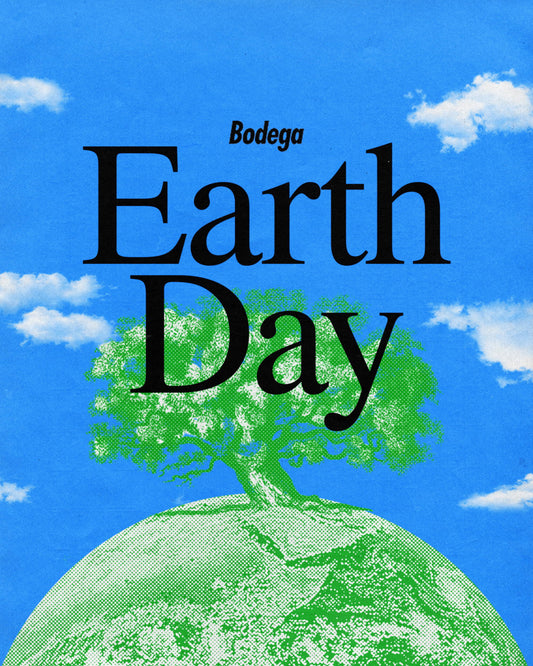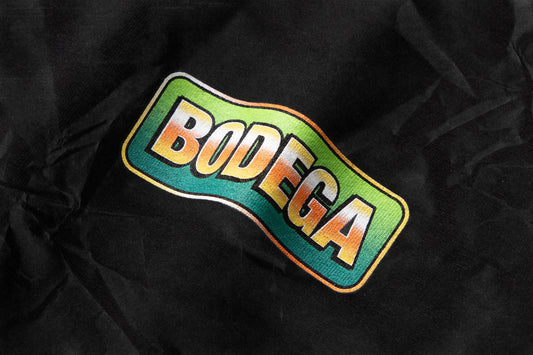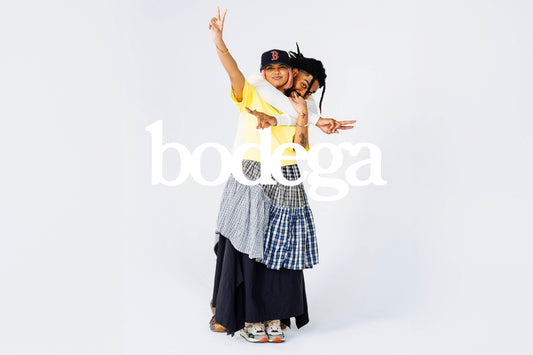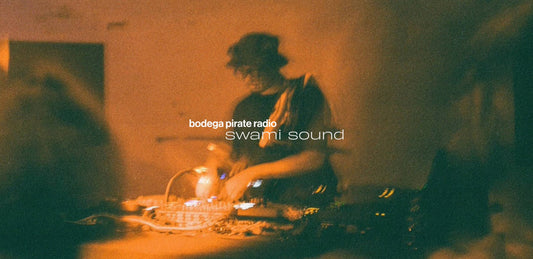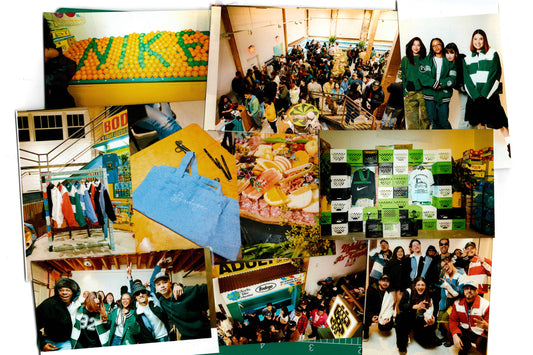Growing up in Queens and the surrounding boroughs throughout the 70s and 80s , Greg Lamarche aka SP. One, got his introduction to graffiti from the streets. Literally. From an early age whether taking public transportation and passing shuttered storefronts to the schoolyard where he played at recess, inspiration was all around.
Honing his skills over the years and developing a distinct style, typography and collage would soon become central to Lamarche’s work with organic movement and energy flowing throw many of his pieces. After leaving NYC for Boston in the early 1990s, Lamarche started the landmark graffiti zine, Skills, which would become an underground hit in the scene. Nowadays Lamarche gets commissioned to paint the same surfaces he once tagged and has been showcased in publications and galleries all over the world. With his latest show “Subscription to Mischief” underway over at the Letterform Archive until November 1st, we sit down with Greg for another Creative Community to talk about the early days, the origins of Skills, how his latest show came together and much more.
Q: Do you remember the first time you were moved by a piece of street art/ graffiti - or even a piece of work in a museum?
A: Growing up in Queens graffiti was always around me. I would see graffiti everyday lining up in the schoolyard during grade school. It was the mid 70s to early 80s and the city was broke and buffing was nonexistent so graff would run for years. One day the custodian was cleaning up on the roof above the auditorium and proceeded to throw all the "roofed" super pinkies, tennis balls, frisbees and whatever else was stuck up there into the playground. As me and other kids were cheering him on and trying to catch something, I saw a patch of roof with exposed black tar and written very crudely in white spray paint it said “we don’t need ladders”. This was the first time I could read something written on a wall. Looking back it was the initial dare that got me interested in writing.
Q: Beyond the ‘graffiti-walls’ at school, was there anything else you can think of that drew you to graffiti and collage in the early days? Your parents were into art right?
A: Yes, they were both art history majors in college so we would draw together when I was a kid, and they brought me to galleries at an early age. My mom took me to a show in 1980/81 that was installed in the lobby of the old Union Carbide building in midtown. It was a site-specific installation by the artist Red Grooms called Ruckus Manhattan. It was a larger-than-life installation and was completely ahead of its time. It was a life-size subway car that you could walk through. All the seats filled with life-size characters built by Grooms. The floor was cut out like a jigsaw puzzle and was on springs so when you walked from one end to the other you had to keep your balance and get the sensation of being on a moving train. Another part of the exhibition was getting into a huge backseat of a NYC cab in front of a large screen with footage of whizzing through the streets of Manhattan. It was an early version of virtual reality. This show left a huge impression on me at a very young age that art could be more than just something hung up on a wall but that it can be an environment that surrounds you and the viewer becomes part of the art.
Q: What role did NYC and especially Queens play in your introduction to this world?
A: It’s where I learned and saw everything first. Forest Hills was an upper and middle-class neighborhood and a lot of writers I met would ask how I started writing coming from an affluent neighborhood like that. Truth is, it was a great place to grow up and write graffiti. There are tons of layups under Queens Boulevard and a whole host of highways to choose from, plenty of truck yards, schoolyards, and there are handball courts for days. There is also Forest Park with walls and overpasses along the freight tracks. Queens provided many excellent opportunities.
Q: You spent some time in Boston for a while after NYC, how was the energy different when it came to street art/ culture?
A: NYC has a longer history than Boston so there was this new energy when I got there. It felt like a graffiti scene still in formation. Boston in the early 90s was a magical era of writing, of course it already had a pretty rich history with the old elevated lines that ran with tags covering the old trolley and rail cars. By the early 90s most 80s writers had quit or slowed down. During the 90s the scene blew up and by 1995 the scene hit a tipping point. It was at this point that the law was about to clamp down on that big time. They started handing out felony convictions like candy for graffiti and some people spent 6, 9, even 12 months locked up just for writing. It was time to go.
Q: For those who may not know, what is Skills Magazine and what was the vision behind it?
A: Skills was a graffiti zine I produced out of Boston from 1992 to 1995. It really was out of opportunity, I had just graduated college in 1991 and the job market was pretty bleak. One day I bumped into a friend who I had graduated with who was the night manager of Copy Cop in the financial district. He said if you ever want to make some color copies let me know. I mentioned to him about making a zine and shortly after we got to it. Printing zines and working the saddle stitcher into the night. After 4 issues I finally was able to step up to offset printing and with support from many local shops on the east and west coast and a huge order from Tower Records I was on the map.
Q: From Mobb Deep, to Black Moon you pulled some heavy hitters in for interviews, are there any stories surrounding specific features that resonate with you to this day?
A: It was fun doing interviews with groups and artists that I really believed in and actually listened to. When we did the Mobb Deep interview they were in the process of blowing up but still had the underground buzzing. Fun fact about this interview is if you look at the person who is doing the interview it just lists them as 1971. It was not uncommon for people to use aliases, it was a graffiti magazine after all, and keeping anonymity was still important for a lot of us. That said, keeping one's identity a secret was mainly because of writing graffiti. In this case, 1971 aka Sacha Jenkins was working for Vibe magazine at the time and was not supposed to write articles for potential competitors, not to say we were a threat to Vibe sales but still had to keep things on the low.
Q: Your upcoming show Subscriptions to Mischief at the Letterform Archive revisits this era and your archive while making the magazine - in addition to a bunch of other things - how did this come together? What compelled you to save all this stuff originally?
A: Part of being a collage artist is being a collector. That would cross over into other areas especially when I did the magazine. I was compelled to keep everything because I was so appreciative of all the mail I received and I felt an obligation to keep everything intact.
A younger writer from the bay area came to visit my studio in NYC over ten years ago. We ended up talking about letters and graffiti for about 4 or 5 hours. Over the years we kept in touch and one day he reached out and mentioned that he was working with the Archive and that they have started to collect magazines pertaining to graffiti and were starting to recognize graffiti as part of the lineage of letterforms. The archive had recently acquired the full run of IGTs, shortly after they would also purchase a full set of Skills magazines. He expressed that there was interest in creating a show and possibly a book highlighting my collection and taking a deeper dive into the scene that surrounded the magazine era of the 90s. The show opened on May 6 and was very well received. The book is still in the works and hope to have it out during the run of the show which closes in November.
Q: You collect paper products and ephemera too, right? Any pieces in your collection that have a special sentimental value? Anything you're still on the hunt for?
A: I definitely have some pieces that I can’t cut up just because it’s unique or just particularly wonderful the way it is. I have some sentimental things too but that's more things like childhood drawings and sketch pads. I have probably enough material for the rest of my life so I don’t hunt as much, that said always down for things with letters, particularly from the 1940-70s era.
Q: Did clothing and personal style ever become intertwined with graffiti? What was your daily uniform back then? Has it changed?
A: Haa I‘m not much of a fashion plate I’m more of a practical dresser. I seem to get paint and ink on everything I own so I spend a lot of time wearing hoodies, t-shirts, and jeans. Never really had a uniform just wore stuff that didn't matter if they got fucked up. Then I would have a nice set of clean clothes for doing normal things, button-down shirts, etc.
Q: There is this theme of explosive vitality that runs through your work, as if pieces start with a kernel and grow organically into a precise jumble. How did this style come to be?
A: For sure there is always a small starting point, especially with the letter pieces. A collage or illustration can start with one letter and end up with hundreds surrounding it. There are many things I’m trying to achieve all at once using letterforms. Creating layering and compositions that play off each other more as design elements utilizing the letter more as form while accentuating its negative spaces at the same time. The movement also plays an important role in many of these works. I feel like when all these elements are working together it does create an energy that is consistent through all my work.
Q: Being typography driven, can you talk about the significance of color, font, and the manipulation of paper in the creative process?
A: My palette is often influenced by vintage spray paint colors, Cascade green, avocado, adobe, dusty pink to mention a few. Again like many of my collage pieces I like the fonts used during the 50s, 60s, and 70s, like Futura, Venus, Umbra, Neil Bold, Profile, and tons more. I’m a bit older so I started with cut and paste before the omnipresence of computers and part of me will continue to keep the tradition of hand cutting and making the majority of my works by hand. As far as manipulation it's kind of hard to answer this part of the question succinctly. Paper is its own creature, it’s technically a living breathing thing that has to be controlled and manipulated to achieve the desired result.
Q: Any advice for the next generation of creatives looking to get their work out there / make art their profession?
A: If one is lucky enough to have a talent, don’t waste it, and if making art or doing something creative is something you have to do no matter what then follow that path and see it through. Also, I’m not directly advocating for everyone to go out and write their name in public but putting your art out there in the public is an important part of realizing what power you might possess.


